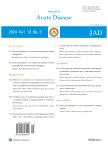Effect of partial depletion of CD25+ T cells on neurological deficit and tissue damage in acute cerebral ischemia rat models
Effect of partial depletion of CD25+ T cells on neurological deficit and tissue damage in acute cerebral ischemia rat models作者机构:Grupo InmunovirologiaFacultad de MedicinaUniversidad de Antioquia UdeACalle70No.52-21MedellínColombia Bacterias&CáncerFacultad de MedicinaUniversidad de Antioquia UdeACalle70No.52-21MedellínColombia Facultad de Ciencias de la SaludCorporación Universitaria RemingtonUniremingtonCalle51No.51-27MedellínColombia Grupo de Inmunología Celular e Inmunogenética(GICIG).Instituto de Investigaciones MédicasFacultad de MedicinaUniversidad de Antioquia UdeACalle70No52-21MedellínColombia Unidad de CitometríaFacultad de MedicinaSede de Investigación UniversitariaUniversidad de Antioquia UdeACalle70No52-21MedellínColombia Grupo de Neurociencias de AntioquiaFacultad de MedicinaSede de Investigación UniversitariaUniversidad de Antioquia UdeACalle70No52-21MedellínColombia
出 版 物:《Journal of Acute Disease》 (急性病杂志(英文版))
年 卷 期:2018年第7卷第6期
页 面:247-253页
学科分类:1002[医学-临床医学] 100214[医学-肿瘤学] 10[医学]
基 金:Universidad de Antioquia UdeA COLCIENCIAS
主 题:Transitory middle cerebral artery occlusion Rat Anti-CD25 Regulatory T cells Ischemia Activated T-lymphocytes
摘 要:Objective: To evaluate the role of regulatory T cells (Tregs) at late stages of stroke. Methods:Anti-CD25 antibody (or PBS as a control) was injected to reduce the pool of Tregs in Wistar rats;then, ischemia was induced transiently by middle cerebral artery occlusion during 60 min and reperfusion was allowed for 7 d. Then, Treg frequency was analyzed in peripheral blood, spleen and lymph nodes. Neurological score (0-6) and infarct volume were also determined. Results: Nine days after injection, the CD4+CD25+ T cells were reduced by 70.4%, 44.8% and 57.9% in peripheral blood, spleen and lymph nodes, respectively compared to PBS-treated rats. In contrast, the reduction of CD4+FOXP3+ T cells was lower in the same compartments (38.6%, 12.5%, and 29.5%, respectively). The strongest reduction of CD25+CD4+ T cells was observed in those FOXP3-negative cells in blood, spleen and lymph nodes (77.8%, 52.8%, and 60.7%, respectively), most likely corresponding to activated T cells. Anti-CD25-treated transient middle cerebral artery occlusion rats had a lower neurological deficit and did not develop tissue damage compared with PBS-treated animals. Conclusions: These findings suggest that treatment with anti-CD25 in our model preferentially reduce the T cell population with an activated phenotype, rather than the Treg population, leading to neuroprotection by suppressing the pathogenic response of effector T cells.



